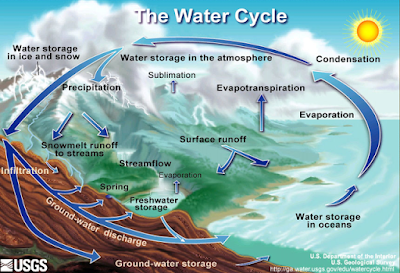WATER
 |
| image credits: wikimedia commons |
Short Q & A based on NCERT Chapter
Q1: What is precipitation?
Answer: The condensation of water vapour in the form of water droplets or ice-crystals and its falling on the earth’s surface is known as precipitation.
Q2: Define glacier.
Answer: The moving mass of ice is called glacier.
Q3: What is the taste of sea water?
Answer: The taste of sea water is salty.
Q4: Why is sea water saline?
Answer: Sea water is saline due to the dissolution of large amount of salt in it.
Q5: How sea tides are caused?
Answer: Sea tides are caused due to the attraction of moon and to some extent that of the sun.
Q6: What is a tide?
Answer: The periodic rise and fall of the sea water is called tide.
Tides are of two types:
(a) High Tides,
(b) Low Tides.
Q7: Name three kinds of water movement.
Answer: The three kinds of water movement are:
- Waves,
- tides and
- currents.
Q8: How much area of the earth is covered by water?
Answer: About 71% area of the earth’s surface is covered by water.
Q9: Name the continents which are surrounded by Atlantic Oceans.
Answer: Atlantic Ocean covers (surrounded) the following continents:
(a) North America
(b) South America
(c) Europe
(d) Africa
Q10: Which ocean provides the busiest sea transport route between North America and Europe?
Answer: Atlantic Ocean provides the busiest sea transport route between North America and Europe.
Q11: Which ocean is shaped like ‘S’ and how much area of the earth’s surface is covered by it?
Answer: The Atlantic Ocean is in ‘S’ shaped and it covers the total 1/6th surface of the earth.
Q12: What are the importance of oceans?
Answer: The importance of the oceans:
- They enjoy a direct influence over the temperature. In regulating the temperature, closeness to the ocean is a major factor.
- A free and permanent route for travel and trade is provided with us by the oceans.
- In the form of waves, they have an immense energy sources.
- Oceans are main sources of fishes and other edible marine life.
Q13: What are the characteristics of warm current?
Answer: The characteristics of warm current:
- It comes from equatorial regions.
- The temperature of the coastal areas are gone up by warm currents.
- Warm currents help in navigation.
- Warm currents keep the port even in the polar region free from ice.
Q14: Distinguish between waves and tides.
Answer:
| Waves | Tides | |
|---|---|---|
| 1. | Waves occur by the pushing action of the winds. | Tides occur mainly by the attraction of the moon and to some extent that of the sun. |
| 2. | In wave-motion, the surface water heaves up and down gently or violently according to the weather conditions. | In tide motion sea-water rises twice a day and falls twice at regular intervals. |
| 3. | Stormy waves may cause disasters. | Tides are very helpful in trading, fishing and navigation. |
Q15: How can you distinguish between a warm current and a cold current?
Answer:
| Warm current | Cold current |
|---|---|
| 1. Warm currents flow from the low latitudes towards the high latitudes. | 1. Cold currents flow from the high latitudes towards the low latitudes. |
| 2. A warm current raises the temperature of nearby areas by making the place warmer. | 2. A cold current makes the nearby places colder. |
| 3. Winds passing over the warm currents absorb a good deal of moisture and bring heavy rainfall over the coastal regions. | 3. Winds passing over the cold currents become dry and cool and bring little or only scanty rainfall to the coastal areas. |
| 4. Warm currents help melting of iceberg and thus remove a menace to navigation. | 4. Cold currents create more icebergs and hence hinder navigation. |
| 5. Warm currents keep the ports free from ice in winter in higher latitudes. | 5. Cold currents help in freezing coastal waters in higher latitudes. |

No comments:
Post a Comment
We love to hear your thoughts about this post!
Note: only a member of this blog may post a comment.